This is the second of three articles in the case study of an avalanche accident that happened on Big St. Joseph Peak on Sunday, January 3, 2021. The first article included an overview of the accident and examined human factors and how heuristic traps can influence our decision making. It can be read here.
I ended the last article talking about deductive competence, or the ability to draw the correct conclusion from the evidence. Heuristics can be overridden through analytic analysis, as long as there is this competence to recognize incongruencies between the two decision making processes, or the ability to recognize errors in the initial decision. Heuristics played into this incident but was not the only variable, observations and tests lead to an incorrect assessment of the hazard.
In this case, small misconceptions in the interpretation of observations influenced the decision to ski the line that slid. In order for observations to result in the right decision, the correct aspects need to be focused on, and the techniques need to fit the avalanche problem. This is where errors occurred. Some of these are subtle, and that is the challenge of them. They are the type of error that normally requires outside assistance to identify. The skiers thought they were doing everything correctly. There was nothing to indicate that errors were made prior to the avalanche. In a benign environment, we may make these mistakes many times and without much consequence until we identify the issue or someone else points it out to us. However, the avalanche environment is what is referred to as a “wicked” learning environment, where the first mistake may be a very consequential one. We may not have the luxury of learning from our mistakes because they could kill us. Luckily, this incident ended well.
Here is some of the information the skiers had heading into the day:
- The avalanche hazard on January 2nd was moderate and the forecast predicted increasing hazard with continued snow and wind, it had this to say about wind slab: “Moderate to strong winds and fresh snow are loading upper elevation slopes and creating wind slabs. Avoid wind loaded start zones greater than 35º”. The January 2nd forecast can be read here.
- The backcountry weather forecast from January 2nd read: “Widespread snow returns this evening lasting into Sunday with the heaviest intensities early Sunday (January 3rd) morning. The heaviest accumulations are expected across the northern Bitterroot mountains with a liquid content of 0.5 to 1.5 inches. Southwesterly ridgetop winds will exceed 55 mph tonight into Sunday as well.” It can be read here.
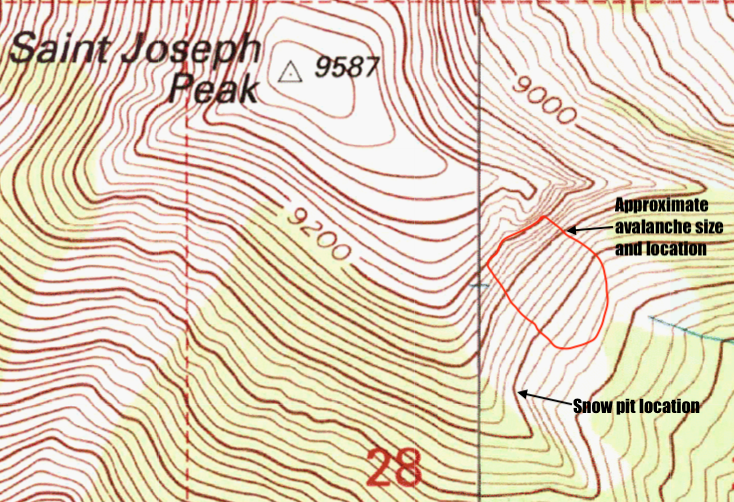
Here is the skier’s synopsis of their decision making process:
The two skiers assessed conditions on their ascent digging pits at 6600’ SE facing, which yielded no results. They also dug at 8800’ on a 32º slope and found 220cm (87”) of snow. The extended column test (ECT) yielded an ECTP 22, down 4” which they judged to have a sheer quality of Q2. Prompted by the Q2 rating, they performed a propagation saw test (PST). It scored as PSTend 80/100 and they judged the likelihood of propagation to be low.
Based on these results, with only 4″ of fresh snow at their pit, and a runout zone free of terrain traps such as rocks or cliffs, they decided to ski the slope one at a time.
Skier two triggered the avalanche, was knocked off their feet, but able to regain control and ski off the slide as it came to a halt. They escaped without injury.
The slide occurred in windslab. The starting zone was between 35-40 degrees, the crown was 300-400’ wide, ranging in depth from 4″-12″, and it slid for about 300′ from 9,000′-8,700’.
This is their analysis of the incident:
“In hindsight, we were following standard protocol but made a bold decision… I think we overlooked the ECTP 22 score because it was only 4″ down, and a PST of 80/100 assisted our decision to continue up. But Big Jo’s East Bowl is huge and with the wind blowing from everywhere with this storm, it is certain that more snow was deposited on other areas of the bowl. We also didn’t observe any cracking, collapsing, or naturals all day, which no doubt contributed to our thought process. Skier 2 had skied this same line on New Years Day which likely played into the heuristic trap we got ourselves into, but also helped us confirm the weak layer.”
I also spoke to the involved skier and clarified some other aspects of their observations used in this analysis.
Some of the factors that led to the incident were:
- Pit location
- The pit dug at 8800’ was on a similar aspect but was 200’ lower than the crown of the avalanche and away from the wind-loaded start zone. Wind slab can be isolated to specific locations, such as just below ridgeline as in this case. A test that is not precisely placed will not give accurate results for this problem. While propagation was found in this pit, the slab was thinner and likely less touchy than the slab that avalanched. In the photos below you can see that the pit is on a low-angle section of ridge subject to winds, while the steep start zone is below the cliffs that block wind and create a deposition zone.
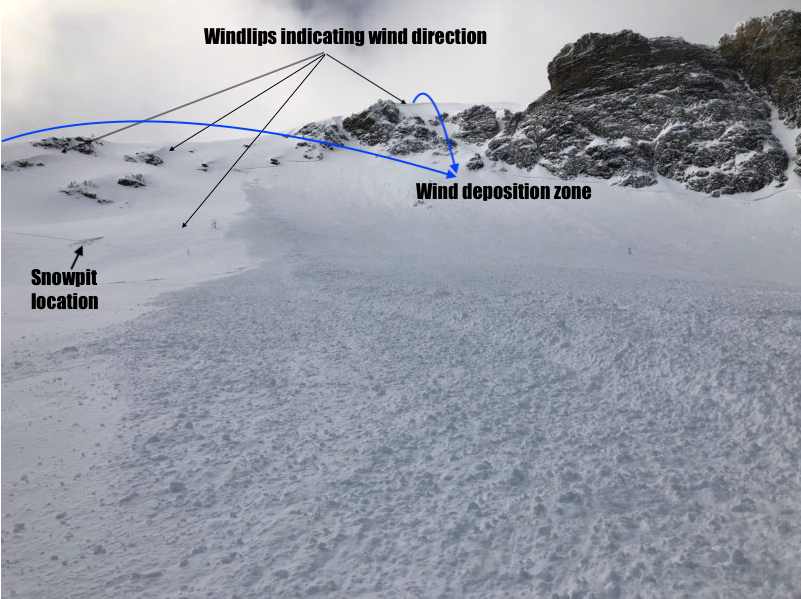
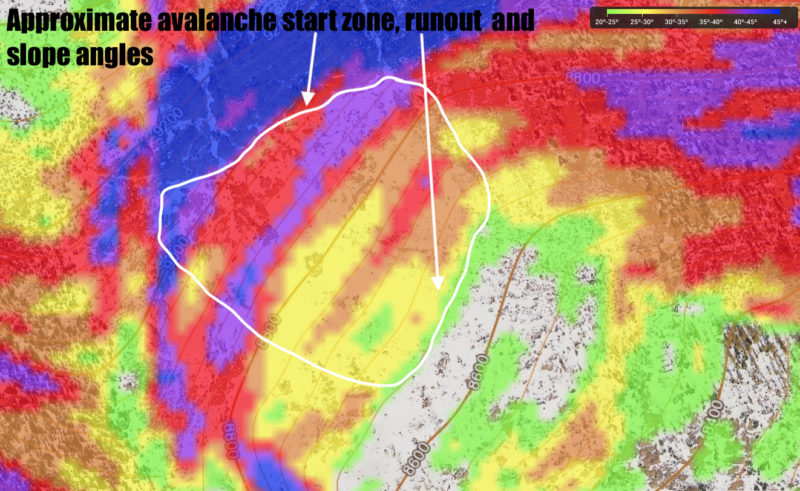
- Tests and scoring
-
- The extended column test (ECT) propagated on the 22nd tap, which means that the structure exists for propagation to travel horizontally under the snow and delaminate the slab from the bed surface. This should be enough information to decide against skiing the slope. However, a quality score was applied to the ECT, rating it a Q2, because the block did not slide off the column. Q scores are not applied to ECT. They were removed from the scoring in 2016 because they introduce a redundant variable that can be misleading. Additionally, most blocks will not slide off on a 32º slope despite a Q1 shear quality. Please see this article for more information. The Q score incorrectly prompted a downgrading of the propagation in the ECT, prompting the PST.
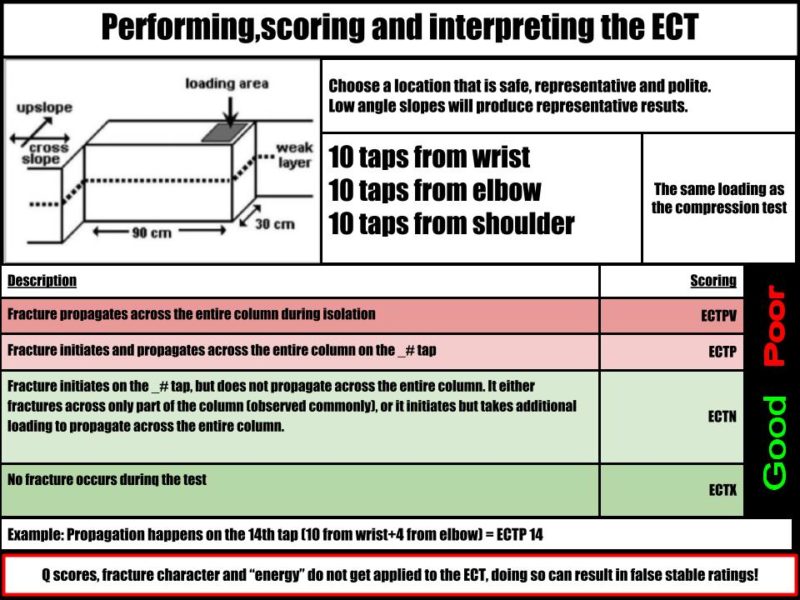
-
- A propagation saw test (PST) was performed to double check the ECT score. The block propagated when the saw was 80% through the block which means there is a low likelihood of propagation. However, the PST has a high false stable percentage in shallow tests and soft snow, such as this one. The PST is more effective in testing definable weak layers such as surface hoar, buried deeper in the snowpack rather than a new snow/old snow interface as in this scenario. As a result, it falsely confirmed stability to the skiers.
- Absence of red flags
- The skiers did not notice any cracking, collapsing, or natural avalanches on their ascent. They noted that it was windy, but downgraded their concern due to the variable direction of gusts. Gusts can be misleading if not on ridge top. Terrain can induce changes of direction at lower elevations. Wind slab can be very specific in its location. Unless informal tests and observations are focused on specific spots, red flags may be missed for this problem type. They did not notice any cracking or collapsing because they were not on a wind-loaded pocket on the ascent.
- Appropriate observations for the avalanche problem
- Wind slab is a fairly predictable avalanche problem, but it can be very isolated. In this case, we can see how the slide was confined to the deposition zone below the cliff band. However, the pit was off to the side on the ridge, where there wasn’t deposition. Because wind slab is so predictable and isolated, stability tests are not necessarily the best way to check for stability. Observations need to be well focused. Weather history, such as that provided by the forecast, and representative test slopes are often better predictors.
These are all simple errors that anyone can make, and many do make, on a regular basis because they are not always recognized as errors. In this case, they stacked up just right to result in an avalanche incident.
The skiers, in this case, did nothing knowingly wrong. The errors they made were not apparent to them because they matched older methods and may have been what they were taught. The misapplication of a good rule, in this case applying Q scores to the ECT, falls under the category of rule-based error, which is hard to detect without outside intervention. This is one small aspect of their decision making process, but it was one of a series of small nudges that created the belief that the slope was stable. Misapplication of the PST, further confirmed the false stable rating, again an error they were unaware of.
This points to the need for ongoing avalanche education. The caught skier had an AVY1 taken in 2010. Since then, many things have changed in the avy world and this may have contributed to errors made. Snow science is always evolving, and avalanche assessment is a complex subject. One 3 day course is rarely enough to cement all the knowledge or develop foolproof techniques.
In addition, personal techniques and methods may shift over time as we develop habits or we are not receiving feedback on potential errors. These may be reinforced as correct because every error we make does not result in an avalanche. The absence of avalanches may be taken as confirmation that we are doing things right. This is another aspect of the wicked learning environment.
Recertifying on a regular basis may be wise. There is not a standard for avy recertification, as there is in first aid but it is worth pursuing. Relearning from experts gives the opportunity for methods to be refreshed and updated and for potential errors to be identified in a safe environment. Some of this responsibility rests on recreationists to seek out courses. Some rests on the avalanche industry to provide refresher courses and resources.
At the very least, reviewing the techniques used in avalanche assessment yearly is good practice.
What can you do to mitigate the factors discussed in this article?
One is a slight change of perspective. When doing stability tests we should be looking for reasons not to ski a slope, exceptions to a stable snowpack, rather than reasons to ski a slope when instabilities are suspected or known.
Another is to use the simplest decision making tools available. If ALPTRUTh or red flags are suggesting not to ski the slope, extra tests are unnecessary and can complicate the process.
In a situation such as this, a simple decision making tool such as ALPTRUTh may have been all that was needed. Stability tests may have added unneeded complexity to the decision making process.
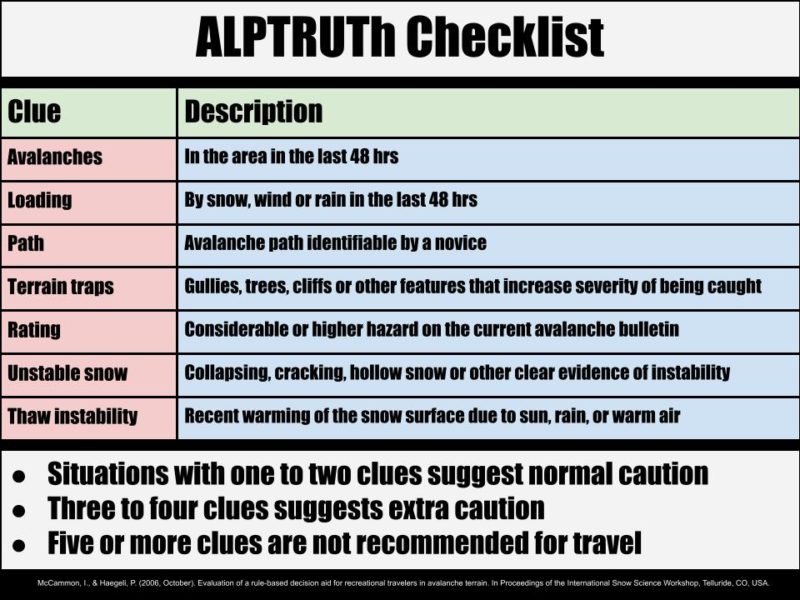
90% of avalanche accidents have three or more of these present. You can read more about ALPTHRUTh here.
In this case, there was loading from wind and an avalanche path. The start zone exceeded 45º in spots. The hazard rating was moderate the previous day but the avalanche forecast predicted rising hazard and specified avoiding wind-loaded terrain greater than 35º. This would check the rating box. They didn’t notice unstable snow, but if they had focused their observations on the wind slab they likely would have seen cracking. With three, and potentially four categories of ALPTRUTh checked, we have extra caution suggested which could have prevented this incident.
Even if stability tests and more complex observations are used in the decision making process, the addition of ALPTRUTh to the final assessment, along with FACETS, may help catch assessment errors or override heuristic traps.
The other piece we can add to manage hazard is a decision on the type of terrain we are going to ride before we even leave the house. By deciding on open and closed terrain before we enter it, we can mitigate hazards further. I’ll discuss this in depth in the next article.
Jeff Carty













